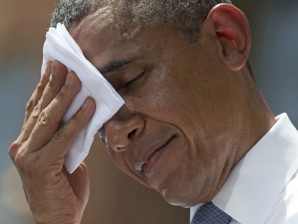
President Barack Obama wipes sweat from his head during a speech on climate change, Tuesday, June 25, 2013, at Georgetown University in Washington. Obama is proposing sweeping steps to limit heat-trapping pollution from coal-fired power plants and to boost renewable energy production on federal property. AP PHOTO/EVAN VUCCI
WASHINGTON—US President Barack Obama on Tuesday laid out a broad new plan to fight climate change, using executive powers to get around “flat earth” science deniers who have blocked action in Congress.
Obama called for new restrictions on existing and new power plants to curb carbon emissions, pledged to push new generation clean energy sources and to lead a fresh global effort to stem global warming.
Officials said the plan would allow the United States to meet a goal of cutting greenhouse gas emissions by 17 percent below 2005 levels by 2020, a pledge Obama made at the inconclusive Copenhagen summit in 2009.
Obama argued that Americans across the country were already paying the “price of inaction” against climate change, describing 2012 as the warmest year in human history, which parched farmlands in the US heartland.
“As a president, as a father, and as an American, I am here to say, we need to act,” Obama said, in a speech delivered in the sweltering early afternoon heat outside Georgetown University, with an eye on his political legacy.
Obama said he had no patience for climate change deniers, including many in Congress, who dispute the science holding that carbon dioxide emissions contribute to a dangerously warming planet.
‘No time for Flat Earth Society’
“We don’t have time for a meeting of the Flat Earth Society,” he said.
“Sticking your head in the sand might make you feel safer, but it is not going to protect you from the coming storm.”
Obama also touched on the Keystone XL pipeline, which is designed to carry oil from the tar sands of Canada to the US Gulf Coast, and has become a cause celebre for environmentalists.
He warned the project, currently under State Department review to determine whether it is in the US national interest, should not be approved if it contributes to global warming.
“Our national interest will be served only if this project does not significantly exacerbate the problem of carbon pollution,” Obama said.
The president is widely expected to approve the long-delayed project when it reaches his desk. The State Department has already concluded in a draft report that it would not significantly harm the environment.
Canadian Natural Resources Minister Joe Oliver said Tuesday he was confident the project would get approved, insisting there would not be “any increase in emissions as a result of the construction of the pipeline.”
Environmentalists, however, insist the pipeline would lead to the expansion of tar sands extraction in Alberta—a process they say creates the “dirtiest” oil on Earth.
Three-pronged approach
Obama’s plan is based on a three-pronged approach: cutting carbon pollution in the United States, mitigating the impact of climate change, and seeking international action to address it.
Obama committed to withdrawing support for coal-fired power plants abroad and offered to discuss new initiatives with big emitters like India and China.
He directed the Environmental Protection Agency to write rules to impose new standards for carbon emissions on new and existing power plants.
The plan calls for $8 billion in loan guarantees to support investments in innovative technologies and aims for a 20 percent increase in energy efficiency in commercial, industrial and residential buildings.
Some opponents of his approach have warned that the plan could result in older coal-fired plants being taken offline and may thereby raise electricity prices for consumers, which could disproportionately hurt the poor.
Officials counter that the plan will reduce the amount of electricity used—thereby reducing fuel bills.
The specifics of much of his plan were unclear, and many of Obama’s new rules could face court challenges that would delay their implementation.
Using executive powers
The president will be using the executive powers of his office since Congress—where there is widespread skepticism of climate change science and fear about the economic impact of mitigation efforts—has refused to act.
Obama also set a goal of reducing carbon pollution by three billion metric tons by 2030—a figure equivalent to more than half of the annual carbon pollution from the US energy sector.
Climate and environmental groups praised Obama’s speech in advance.
Larry Schweiger, president and CEO of the National Wildlife Federation, said his speech was an “important step in the journey to end industrial carbon pollution.”
Bob Ward, policy and communications director at the Grantham Research Institute on Climate Change and the Environment at the London School of Economics, welcomed Obama’s “personal leadership.”
But he warned: “Without the support of Congress for new federal legislation, the president is fighting this battle with one hand tied behind his back.”
And Bill Snape, of the Washington-based Center for Biological Diversity, said what Obama was proposing “isn’t big enough, and doesn’t move fast enough, to match the terrifying magnitude of the climate crisis.”
Republicans meanwhile accused Obama of waging a “war on coal” that would slap onerous regulations and unreasonable environmental targets on power stations—a few shared by some Democrats.
Democratic Senator Joe Manchin, from the coal-producing state of West Virginia, said Obama’s plan would have “disastrous consequences” for the recovering economy.—Stephen Collinson